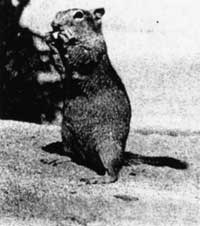|
CRATER LAKE
NATURE NOTES
National Park Service
Crater Lake National Park |
|
Crater Lake National
History Association |
|
Volume XVI
1950 |
|
NATURE NOTES from Crater Lake National Park are issued from time to
time by the Crater Lake Natural History Association to foster an
appreciation and interest in the natural history of the park. It is
distributed free to members of the association. Reprinting of articles
appearing in NATURE NOTES is encouraged. It is requested that
acknowledgment of the source be made by giving the name of the author
and of this publication.
|
E. P. Leavitt
Superintendent |
|
Dr. G. C. Ruhle
Editor |
Mammal Puzzles
By Denis J. Illige, Ranger-Naturalist

Where did it come from?
Not infrequently an animal is recorded from a locality where it has
never before been known to occur. Such was reported by several members
of the staff, Crater Lake Lodge employees, and some park visitors.
Various descriptions were given of a strange creature living near the
lakeside porch of the lodge. Descriptions were as varied as the number
of reports, but all observers agreed that the new animal was
squirrel-like in appearance, gray in color, very short-eared, and with a
tail rather short for the body length. Some fantastic postulations were
made, such as the possibility of a mutation of the golden-mantled ground
squirrel, or of a hybrid between the ground-squirrel and the arboreal
chickadee!
The mystery was deepened by the fact that the stranger appeared
suddenly about the middle of August, and seemed to be quite tame.
Visitors were happy over another animal which could be fed peanuts! On
August 21, the little animal was brought to Park Headquarters for
examination. In general appearance it was obviously a member of the
ground-squirrel genus Citellus, but to what species did it
belong? The body had no distinct pelage pattern; as had been described,
the ears were very short, the feet quite large, and the tail short in
relation to the body length.
From a careful check on descriptions of Citellus in Anthony's
Field Book of North American Mammals (1928), and Bailey's Mammals and
Life Zones of Oregon (1936), this specimen can apparently be only C.
oregonus (Merriam), the Oregon ground-squirrel. This knowledge,
however, doesn't explain how it came to occupy the vicinity of the lodge
porch. This question of origin is particularly interesting in light of
the fact that this is the first authentic record of this species in
Crater Lake National Park.
Because the new visitor appeared suddenly, and was quite tame, it
was probably brought in by a tourist. Whatever the cause of its arrival,
it now is a permanent resident of the park zoological collection,
available for reference and demonstration purposes.
Why did it die?
A Rocky Mountain mule deer fawn (Odocoileus hemionus hemionus)
was found in a weakened condition in the northeastern part of the park
on August 22. The trail crew came across the little buck when they
stopped to eat lunch. It appeared to be hungry, perhaps even starving,
so they offered it some of their lunch milk, which it gulped avidly.
The crew foreman put the fawn in his pick-up and brought it to
headquarters, but it died on the way. Weighed and measured at the
warehouse, it was very slight for the body dimensions. It weighed 28
pounds and was 42 inches in total length. It was at least three months
old according to the degree of tooth eruption. A brief field autopsy
showed no obvious parasitic condition to cause death, and no easily
detectable disease symptoms. The ruminant stomach was about half full of
vegetable food, but seemed to be deficient in moisture content.
The dental condition also did not indicate an inability to feed on
browse, as the deciduous teeth were all functional, and the last molars
had just penetrated the gum line. There was no mesenteric or
subcutaneous fat on the fawn, and the general appearance of the animal
was of gaunt hunger. Had his mother met an untimely end? Was he not yet
weaned, and the food in his stomach only a desperation attempt to
survive? Why did he die in infancy, and what factors brought on his
death? Here are questions one asks of nature.
What is he doing here?
On the evening of August 19, while talking to some park guests on the
lakeside porch of the lodge, a cony (Ochotona princeps) was seen
several times hopping across the lighted area before the open lounge
doors. Since lodge porches are definitely not the habitat favored by
conies, and as they are not known to relish peanuts or other park
visitor squirrel-bait, what was this rock-loving cousin of the rabbit
doing here? Perhaps he was curious about the activity in the lounge, as
he stopped and seemed to peer inside the open doors each time he
traversed the lighted area.
|

